Susquehannock
Susquehannock people, also called the Conestoga by the English,[2] were Iroquoian-speaking Native Americans who lived in areas adjacent to the Susquehanna River and its tributaries ranging from its upper reaches in the southern part of what is now New York (near the lands of the Five Nations of the Iroquois Confederacy), through eastern and central Pennsylvania West of the Poconos and the upper Delaware River (and the Delaware nations), with lands extending beyond the mouth of the Susquehanna in Maryland along the west bank of the Potomac[3] at the north end of the Chesapeake Bay. Evidence of their habitation has also been found in northern West Virginia and portions of southwestern Pennsylvania, which could be reached via the gaps of the Allegheny or several counties to the south, via the Cumberland Narrows pass which held the Nemacolin Trail. Both passes abutted their range and could be reached through connecting valleys from the West Branch Susquehanna and their large settlement at Conestoga, Pennsylvania.
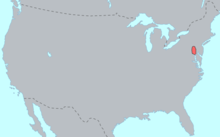 Distribution of the Conestoga (Susquehannock) language | |
| Total population | |
|---|---|
| Absorbed as a tribe | |
| Regions with significant populations | |
| New York, Pennsylvania, Maryland | |
| Languages | |
| Conestoga (Susquehannock) | |
| Religion | |
| Native | |
| Related ethnic groups | |
| Iroquois (Haudenosaunee), Erie people, Neutral Nation, Huron peoples (Wyandot), Tabacco peoples, Tuscarora, & Cherokee[1] |
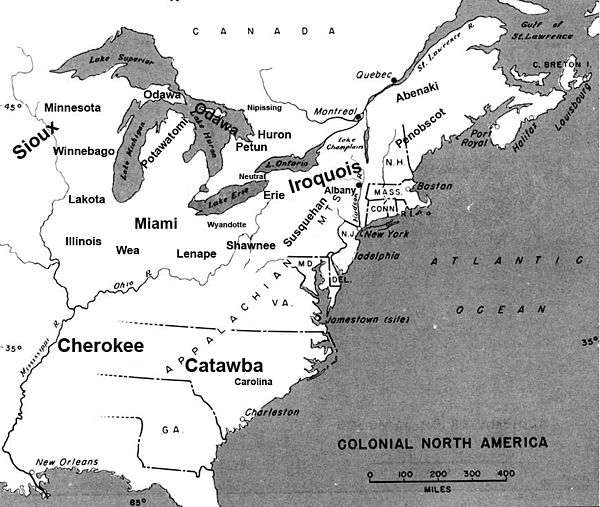
Language
Conestoga (Susquehannock) was an Iroquoian-speaking people, this fact [1] may indicate they were at odds with the Algonquian-speaking Lënape (Delaware people) to the east.[1] Little of the Conestoga language has been preserved in print. The chief source is a Vocabula Mahakuassica compiled by the Swedish missionary Johannes Campanius during the 1640s. Campanius' vocabulary contains about 100 words, and is sufficient to show that the Conestoga language is a Northern Iroquoian language, closely related to those of the Haudenosaunee Confederacy Nations (Five Nations).[1][4] Unfortunately peace with the Haudenosaunee Confederacy was as difficult to achieve as peace was with the Lënape.[1]
.jpg)
When Europeans penetrated the interior of the East Coast of "North America" from the coastal areas dominated by Algonquian language-speaking Nations, the Europeans usually learned the names of Nations by what the First Nations who were coastal whom the Europeans had encountered, had called them. This is particularly true for the Susquehannock, who lived near Algonquian language-speaking peoples who were generally hostile to the Susquehannock. After a brief period of contact with Europeans, the Susquehannock faced overwhelming depopulation[1] due to epidemic disease—a reality which affected the indigenous peoples of what are now known as "the Americas".[1]
Names
The Europeans adapted or transliterated these names according to their own languages and spelling systems, trying to capture the sounds of the names.
- Huron, another Iroquoian-speaking people, called these people Andastoerrhonon, meaning "people of the blackened ridge pole", related to their building practices.[5]);
- The French adapted the Huron term and called them the Andaste (Andastes in plural);
- The Lenape/Delaware, an Algonquian people, used an ethnonym for their traditional enemy, Mengwe, which meant "without penis"[6] or Miqui, which means "foreign, different, far off."[7] the Dutch and Swedes derived their term of Minquas for the people from this term. The Lenape also used the term Sisawehak Hanna Len or "Oyster River People."[8]
- The Powhatan-speaking peoples of coastal Virginia (also Algonquian) called the tribe the Sasquesahanough.
- The English of Maryland and Virginia transliterated the Powhatan term, referring to the people as the Susquehannock.
- The English of Pennsylvania in the late eighteenth century called them the Conestoga,[1] derived from one of their few remaining villages in Pennsylvania known as Conestoga Town. Its name was based on the Iroquoian term, Kanastoge, possibly meaning "place of the upright pole."[4][9]
- Early English and Dutch traders heard and spelled the people's main settlement, fort, or castle, as "Quanestaqua."[10]
History
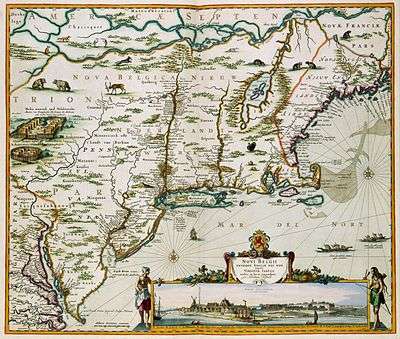
According to recorded histories, the Susquehannock told Europeans that they originally came from a large river valley to the west. Europeans who wrote this down seemed to assume that the Mississippi River was meant, however no Iroquoian people have ever been found in the Archaeological records of the region. Iroquoian peoples were, however, believed to have held a much larger region of Ohio at some point between the 13th & 16th centuries, when European colonization began. They also, however, claimed to have joined with other peoples once east of the Appalachian Mountains to form their nation. Studying the linguistics of recorded examples of the Susquehannock language, it appears to have been closely related to that of the Onondaga.[4] It is most likely that both are correct.[11] Similar to how the Haudenosaunee Confederacy (Iroquois Confederacy) was organized, there were said to be several distinct tribes of the Susquehannock. Capital towns were named by John Smith as Attock, Quadroque, Tesinigh & Utehowig.[12]
The original population numbers for the Susquehannock is uncertain due to lack of contact with the Europeans, whose records provide such data. The Europeans' best guesses were that the tribe numbered from 5000–7000 in 1600, and that the Susquehannock was a regional power capable of holding off the Haudenosaunee Confederacy[1] in the first seven decades of the 17th century, including after the Haudenosaunee Confederacy began systematic warfare against neighboring ethnic groups in pursuit of acquiring firearms during fur trading.[1] Before that time, it was the inland Susquehannock who had allied themselves to Dutch and Swedish traders (1600 & 1610) and Swedish settlers in New Sweden around-1640 who had a monopoly on European flintlock firearms, increasing the tribe's power.[1] These firearms were carefully not traded to Haudenosaunee Confederacy or Lënape[1] until the defeat of the Dutch[13] imposed British traders, who initially favored the Haudenosaunee Confederacy,[1] into the North American Native Nation rivalries and also kept firearms away from the more coastally located Lënape Nation.
Prior to 1640, the Susquehannock peoples may have decimated bands of the Lënape Nation in the greater central Delaware Valley region,[1] including raids in force across the Delaware River into what is now central New Jersey. Due to these Susquehannock raids, the Lënape Nation had become a tributary nation of the Susquehannock Nation following a war with the fierce Susquehannock before 1640.[1]
The Susquehannock (whose population had been greatly killed off by the time the British tried to assert any significant control over the Susquehannock Homeland) had early on allied with the Swedes, who traded Dutch firearms for Susquehannock furs as early as the 1610s. At this point in time, the Susquehannock were generally opposed to the policies of the new European managers of the colonies of Maryland and Pennsylvania. Consequently, the Susquehannock defended themselves from attack in a war declared by the colony/Province of Maryland[1] from 1642-50s and won it, with help from their long-time allies the Swedes.
During the mid-17th Century, the Susquehannock found that the English fur traders would trade European firearms, that the Susquehannock greatly desired, for Susquehannock possessed beaver skins. Due to the trade deals that the Susquehannock were getting from the English fur traders, the Haudenosaunee Confederacy began warring against other Nations in the region in order to monopolize the richest fur bearing streams.[1] When the Haudenosaunee Confederacy attempted to impose their will upon the Susquehannock circa 1666, the Susquehannock achieved a great victory against the combined forces of the Seneca nation and Cayuga nation of the Haudenosaunee Confederacy (Five Nations of the Iroquois),[1] severely damaging the southern populations of both these western Haudenosaunee Confederacy Nations.[1]
Susquehannock authority reached a zenith in the early 1670s,[1] after which the Susquehannock suffered an extremely rapid population and authority decline in the mid 1670s,[1] - presumably from infectious diseases such as smallpox, which also decimated other Native American groups such as the Mohawk and other Iroquois language speaking Nations.[1] By 1678, drastically weakened by their losses, the Susquehannock were overwhelmed by the Haudenosaunee Confederacy,[1] though some small groups are believed to have fled west via the gaps of the Allegheny into land which was beyond European Colonial influence including into the Ohio Country, possibly becoming absorbed by the Shawnee.[1] Their numbers in their Susquehanna Valley homeland may have diminished to as few as about 300 counted persons in 1700 with another remnant group well to the west in the Allegheny settlement the English called the Conestoga people near Conestoga, Pennsylvania.[1] Before the American Revolution, in mis-targeted response to rumors that they were supporting Pontiac's War, the Susquehannock living in Conestoga Town were massacred by the Paxton Boys. The last two known Susquehannock, a couple named Michael and Mary, were sheltered from the massacre on a farm near Manheim, Pennsylvania and were buried on the property when they died.[14][15][16]
Society
The Susquehannock society was a confederacy of up to 20 smaller tribes, who occupied scattered villages along the Susquehanna River. Most Native American Nations of the time and of today had and have clans. The Susquehannock, being Iroquoian most likely had clans as well. Following the general value of matri-local clan lineage of most Iroquoian peoples, the Susquehannock were likely originally a matri-lineal culture. This would mean in traditional terms, that the line of descent would be traced through the mother or closest female relative. The Susquehannock Nation remained independent and not part of any other confederacy into the 1670s. Ultimately, they were not strong enough to withstand the competition from colonists and other Nations in their piece of the so-called Beaver Wars of that century.[17] About 1677 many Susquehannock people, decimated by disease and war, merged with their former enemies and Iroquoian language kin, the Haudenosaunee (Iroquois) Five Nations, who were to the North of the Susquehannock Homeland in what is now called in New York. The Haudenosaunee Confederacy became the successor government to that of the Susquehannock due to the Covenant Chain. This meant that the Haudenosaunee Confederacy now took over the governance of the Susquehannock Homeland.
Susquehannock people lived in longhouses like the Haudenosaunee did. The Susquehannock villages were palisaded so that enemies could not easily attack the longhouses in the village. Corn was such an important crop that John Campanius Holm actually recorded the Susquehannock word for it. The Susquehannock kept dogs as indicated by the vocabulary that John Companius Holm wrote. Other important animals for the Susquehannock were turkey, deer, bear, beaver, otter, foxes, and elk. As is seen in the depiction of the Susquehannock man above, men went to war with bows and arrows, and war clubs. The vocabulary is written by John Companius Holmes also includes words specifically meaning "smoking tobacco", as well as the word for "pipe for smoking tobacco" which indicates that tobacco smoking was an important part of Susquehannock life. The cut of the hair of the Susquehannock man pictured shows a hairstyle similar but different from that of the Haudenosaunee Confederacy Nations.
Travel was both on water and on land. On the water, it was via canoe, and several place names indicate locations where the portage was needed between river or stream sections. The main thoroughfare would have been what is today called the Susquehanna River. The length and navigability of this river via canoe would have allowed the Susquehannock to be a powerful regional force and to have strong internal trade routes between sub-tribes and clans. The Susquehanna River is navigable by canoe from near its source in what is now New York to its mouth in the Chesapeake Bay. The location of the Susquehannock Homeland indicates that the Susquehannock language likely contained words for mountains, river features, land animals, plants, fish, coastal species, as well as for the land that was flat. The Pennsylvania Bison was likely hunted by the Susquehannock since the Pennsylvania Bison was found in the Susquehannock Homeland. Breaks in the mountain range would have allowed for over-land travel via well-worn trails. Most travel would likely have been inside of the valleys between the ridges. This would have meant that the Susquehannock had access to trade from what is now the Southeast of the United States via the valley systems. This would mean that the Susquehannock could have traded with the Cherokee directly since the Cherokee were directly South of the Susquehannock Homeland. The Cherokee are another Iroquoian people and it is possible that the languages were not hard for one or the other Nation to learn.
Conestoga(Susquehannock) Society would have been impacted and defined by its location. When viewed in a pre-Colonial context, the homelands of the Nations of the Haudenosaunee Confederacy are directly to the North of the Conestoga Homeland. Directly down the Appalachian mountain and valley ranges were the Cherokee. The Conestoga was a Central Iroquoian people and as such occupied a region of the Appalachian Mountains that was critical to trade and travel along the south-north axis that most of the valleys occupy. This would have enabled the Conestoga to be prosperous in trade with the Cherokee, defended from the North against the Haudenosaunee Confederacy due to the vast Appalachian mountain and valley region, and shielded up to a point from the Lënape to the East. To the West, the Appalachian Mountains would have shielded the Conestoga from the Algonquian Shawano (Shawnee) and thus prevent the threat of invasion from that direction. Thus the Conestoga enjoyed life in a natural fortress due to protection on 3 sides from the Appalachian Mountains and valleys.
Conestoga villages were likely traditionally built on top of ridges of the Appalachian Mountains when such ridges were available. The Conestoga site in what is now Sayre, Pennsylvania is evidence for this. At this site was likely a religious complex, known currently as Spanish Hill. Spanish Hill is possibly an artificial hill, and possibly natural. Research is still being conducted regarding this issue. Building on the ridges would have allowed the Conestoga to view from the safety of their villages the surrounding area, which was likely used for farming of corn, beans, and squash. This pattern of using the land near the rivers and streams for farming has been found in many Native American societies in the East of Turtle Island (North America). Building villages on ridge tops would have allowed the Conestoga to observe advancing enemy movements and to be safe in times of flood. The Conestoga lived in settled villages and were not known to be nomadic. The Conestoga Homeland is the most flood-prone area of the East of Turtle Island, owing to the number of rivers and their tributaries. The Conestoga likely practiced sylvan agriculture like the other Native Nations of the East of Turtle Island. Nuts and berries would have been harvested from the forest and mushrooms would probably have been harvested as well. Harvest time for many berries and nuts can be ascertained from the current wild availability of the berries and nuts in the Conestoga Homeland. Harvest time for corn, beans, and squash was likely late Summer till early Fall. Following the normal seasonal festival/religious patterns of other Iroquois people, the Conestoga most likely followed a seasonal calendar of planting, harvest, and Winter festivals.
Dreams were likely important to Conestoga people. All other Iroquoian peoples put great stock in dreams and the Conestoga was likely to have thought dreams to be important too.
Archeological materials have been found in Pennsylvania and Maryland's Allegany County at the Barton (18AG3) and Llewellyn (18AG26) sites. West Virginia's Grant, Hampshire and Hardy counties region (Brashler 1987) also have archaeological sites where Susquehannock ceramics have been found.
Archeologists have also found evidence of these people along the Potomac River and its tributaries. They have classified these artifacts as the "late Susquehannock sequence". A Contact Period (1550~1630) Susquehanna site, 46Hy89,[18][19] is located in the Eastern Panhandle at Moorefield, West Virginia.[20]
The English seldom visited the upper Susquehanna inland region during the early colonial period. It is likely that the Conestoga had occupied the same lands for several thousand years. When Captain John Smith of Jamestown met them in 1608, they had a formidable village in the lower river valley (present-day Lancaster, Pennsylvania developed near here.) Captain Smith wrote of the Susquehannock, "They can make neere 600 able and mighty men, and are pallisadoed [palisaded] in their Townes to defend them from the Massawomekes, their mortal enemies."[21] He was astonished to find the Conestoga were brokering trade with French goods. He estimated the population of their village to be 2,000, although he never visited it.
The French explorer Samuel Champlain noted the Conestoga in his Voyages of Samuel Champlain; in 1615, he called one of their 20 villages, Carantouan. It was located on the upper Susquehanna River near present-day New York state. It rallied more than 800 warriors with two other villages, Champlain reported.
Modern estimates of the total Conestoga population, including the whole territory in 1600, range as high as 7,000 people. During the sixteenth century and carrying forward into the first decades of colonization, the Conestoga were the most numerous people in what is now called the Susquehanna Valley.
During the early Dutch colonization of New Netherland, the Conestoga traded furs with the Europeans. As early as 1623, they struggled to go north past the Lenape (later known as the Delaware), who occupied territory along the Delaware River, to trade with the Dutch at New Amsterdam. In 1634, the Conestoga defeated the Lënape in that area, who may have become their tributaries.
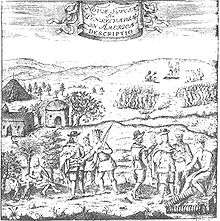
In 1638, Swedish settlers established New Sweden in the Delaware Valley near the coast. Their location near the bay enabled them to interrupt the Conestoga fur trade with the Dutch further north along the coast.
In 1642, the English Province of Maryland declared war on the Conestoga. With the help of the Swedes, the Conestoga defeated the English in 1644. The Conestoga were in an intermittent state of war with Maryland until 1652. As a result, they traded almost exclusively with New Sweden to the north.
In 1652 the Conestoga concluded a peace treaty with Maryland. In return for arms and safety on their southern flank, they ceded to Maryland large territories on both shores of the Chesapeake Bay. This decision was also related to the Beaver Wars of the late 1650s, in which the Haudenosaunee swept south and west against other tribes and territories to expand their hunting grounds for the fur trade. With the help of Maryland's arms, the Conestoga fought off the Iroquois Confederacy for a time, and a brief peace followed.
In 1658, the Conestoga used their influence with the Esopus to end the Esopus Wars, because that conflict interfered with their important trade with the Dutch. From 1658 to 1662, the Conestoga were at war with the powerful Haudenosaunee Confederacy (based south of the Great Lakes) which was seeking new hunting grounds for the fur trade. By 1661, Maryland colonists and the Conestoga had expanded their peace treaty into a full alliance against the Haudenosaunee Confederacy. Fifty Englishmen were assigned to the Conestoga to guard their fort.
In 1663, the Conestoga defeated a large Haudenosaunee Confederacy invasion force. In April 1663, the Conestoga village on the upper Ohio River was attacked by Seneca, Cayuga, and Onondaga warriors of the western Iroquois. (JR: 48:7-79, NYCD 12:431).
In 1669–70, John Lederer was guided by a Conestoga man on his journey to the southwest Virginia and North Carolina (Mooney 1894:32). Paul A. W. Wallace writes, "In 1669 Iroquois Indians warned the French that if they tried to descend the Ohio River they would be in danger from the "Updates." (Susquesahanocks: Wallace 1961:13).
In 1672, the Conestoga defeated another Haudenosaunee Confederacy war party. The Haudenosaunee Confederacy appealed to the French colonial government for support because the Haudenosaunee Confederacy could not "defend themselves if the others came to attack them in their villages". Some old histories indicate that the Haudenosaunee Confederacy ultimately defeated the Conestoga, but no record of a defeat has been found.[22] In 1675 the Conestoga suffered a major defeat by the Haudenosaunee Confederacy. English colonists invited the tribe to resettle in the colony of Maryland, where they relocated. It needs to be noted that this was not a territory unfamiliar to Conestoga people because this part of the colony of Maryland was actually the Southern area of the Conestoga Homeland.
The Conestoga suffered from getting caught up in Bacon's Rebellion the following year.[23] After some Doeg Indians killed some Virginians, surviving colonists crossed into the colony of Maryland and killed Conestoga in retaliation. The Conestoga moved to old Fort Piscataway, below present-day Washington, DC. Problems on the frontiers led to the mobilization of the militias of the colony of Maryland and the colony of Virginia. In confusion, the colonial militias of Maryland and Virginia surrounded the peaceful Conestoga village. When five Conestoga Chiefs came out of their village to negotiate with the colonial militias of Maryland and Virginia, the colonial militias murdered the five Conestoga Chiefs. The Conestoga left their own village at night and harassed colonists in the colonies of Virginia and Maryland. The Conestoga from this village eventually returned to the area of the Susquehanna River.
Covenant Chain Treaty
In 1676 the Haudenosaunee Confederacy made a peace with the colony of Maryland and the colony of Virginia, and the Lënape/Delaware. In a treaty with the Conestoga, the Haudenosaunee Confederacy offered to shelter the Conestoga, distant relations through the Iroquoian-language family, and sometimes allies.[1]
Around 1677, most of the remaining Conestoga moved to New York, joining mostly with the Seneca and Onondaga Nations, who also spoke Iroquoian languages. The Haudenosaunee Confederacy, which had a long tradition of adopting defeated enemies into their tribes,[1] and Governor Edmund Andros of the colony/Province of New York told the Conestoga that the Conestoga would be welcome in the lands of the Haudenosaunee Confederacy and protected from the colonies of Maryland and Virginia. Some Conestoga returned to their homeland on the southern shores of the Susquehanna River, keeping their distance from the center of the Haudenosaunee Confederacy. Others moved to the upper Delaware River into the somewhat depopulated Delaware Nation lands (ravaged both by the Conestoga who had made them tributary Nations, and the Haudenosaunee Confederacy, which had competed with the Algonquian-speaking peoples and had attempted to bring the Algonquian-speaking Nations under The Covenant Chain), where they lived under the protection of the colony of New York.
After adopting the majority of the Conestoga, the Iroquois acquired most of the territory along the Susquehanna River, but they never claimed below the Fall Line. Some of the Conestoga people merged with the Meherrin, and allied Nottoway or Mangoac, the Iroquoian-speaking tribes located in what was then the colonies of Virginia and North Carolina. The new group called themselves Chiroenhaka, according to the 20th-century ethnologist James Mooney. As of 2009, researchers found archaeological evidence of Conestoga movement into and habitation of areas such as the Mouth of the Seneca[24] and Pancake Island[25] villages in present-day West Virginia, according to Bryan Ward, West Virginia Division of Culture and History.
The Conestoga population had been devastated by high fatalities from new Eurasian infectious diseases, to which they had no immunity, followed by warfare. About 1697, a few hundred Conestoga people settled in a new village in what is now known as Lancaster County, Pennsylvania called Conestoga Town. The river was at that point named the Conestoga River under the colonial governor of the colony of Pennsylvania, Governor William Penn. A type of wagon was named for them that was later used by pioneers migrating west. Hardware kits for the wagons were made on the east side of the Allegheny Mountains. In the early 1700s, some Conestoga migrated to Ohio, where they merged with other tribes, becoming known as the Mingo.
The Conestoga people at Conestoga Town lived under the protection of the provincial Pennsylvania government, but their population declined steadily. In 1763, a census counted twenty-two people in Conestoga Town. That year the Paxton Boys, in response to Pontiac's Rebellion on the western side of the Allegheny Mountains, attacked Conestoga Town (which was located on the eastern side of the Allegheny Mountains and had nothing to do with Pontiac's war of resistance to European colonial encroachment),[26] killing six people. The remaining Conestoga inhabitants of Conestoga Town were sheltered in a Lancaster workhouse by the colonial government of the colony of Pennsylvania. The governor of the colony of Pennsylvania discouraged further violence, but two weeks later, the Paxton Boys killed the 14 Conestoga people who were staying at the workhouse.[26]
The Conestoga negotiated a treaty with the whites allowing settlement in the Conestoga Homeland. The Conestoga Chiefs making the negotiation never made a treaty giving up the lands to the whites for white ownership or administration. Due to the ever-changing relationship of Aboriginal Americans (American Indians/Native Americans) to colonists and colonial governments, then finally after 1776 with the government of the new United States, the Conestoga homeland was never officially ceded to the United States of America. The Covenant Chain prevented the Conestoga from making any such treaty of cession of any of the Conestoga Homeland to the United States and remains respected by Conestoga people to this day.[26]
Legacy
- Susquehannock State Park in Pennsylvania is named for the tribe.[26]
- Susquehannock High School of Southern York, Pennsylvania is named for the tribe.
- Susquehanna is a combination of two different languages, with the "Susque" portion of the word being a native Conestoga word, and the "hanna" part of the word comes from Algonquian language stock. "Hanna" means "river".
- The "ock" part of the word "Susquehannock" is of Algonquian language stock origin and indicates a nation of people.
- Conestoga is the more accurate ethnonym for the people rather than "Susquehannock".
- Toponyms of the Conestoga Homeland show the continued presence of the language of the Conestoga people.
- For further reading on the Conestoga vocabulary collected by John Campanius Holm, interested parties can buy "A Vocabulary of Susquehannock" which is now published by American Language Reprints, 2 Evolution Publishing
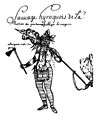 Drawing of a Susquehannock ca. 1675
Drawing of a Susquehannock ca. 1675 Susquehannock Fort ca. 1671, in present-day York County, Pennsylvania
Susquehannock Fort ca. 1671, in present-day York County, Pennsylvania
Historical Iroquoian Peoples
- Akhrakouaeronon
- Cherokee
- Chonnonton
- Conestoga
- Erie
- Huron
- Haudenosaunee Confederacy/Iroquois
- Meherrin
- Mohawk
- Petun (See also Protohistory of West Virginia )
- Tuscarora (Also Nottoway )
Footnotes
- Editor: Alvin M. Josephy, Jr., by The editors of American Heritage Magazine (1961). pages 188-219 (ed.). The American Heritage Book of Indians. American Heritage Publishing Co., Inc. LCCN 61-14871.CS1 maint: multiple names: authors list (link) CS1 maint: extra text: authors list (link)
- The American Heritage Book of Indians, pages 188-189
- Henry George Hahn, Carl Behm, Towson: A Pictorial History of a Maryland Town, pgs. 12-13, Baltimore, MD: Donning Co., 1977, ISBN 0-915442-36-1
- Marianne Mithun. 1981. "Stalking the Susquehannocks," International Journal of American Linguistics 47:1-26.
- Wallace: Indians in Pennsylvania
- Brinton, 81
- Brinton, 85
- Brinton, 132
- J.N.B. Hewitt. 1907. "Conestoga," Handbook of American Indians North of Mexico. Frederick Webb Hodge, ed. Smithsonian Institution Bureau of American Ethnology Bulletin 30, Washington, D. C.: Government Printing Office. 335-337
- As cited in Schutt, 64.
- http://www.hsobc.org/on-the-susquehannocks-natives-having-previously-used-what-is-now-baltimore-county-as-hunting-grounds/
- http://www.pa-roots.com/clearfield/earlyindianhistory/earlyindianhistory.html
- English conquest of New Netherlands in 1667 imposed British control over the entire Atlantic Seaboard from Georgia to New France. see: Second Anglo-Dutch War
- Brubaker, Jack (26 November 2010). Massacre of the Conestogas: On the Trail of the Paxton Boys in Lancaster County. The History Press. ISBN 9781614232759.
- "Kreider Farms honors Native American burial site". Farm and Dairy. Retrieved 17 June 2020.
- "Susquehannock Grave Site". OpenStreetMap. Retrieved 17 June 2020.
- Dean R. Snow, The Archaeology of North America, Pearson, 2009
- "Susquehannock, Images from Moorefield Village Site 46Hy89", Council for West Virginia Archaeology
- Maymon, Jeffery H. and Thomas W. Davis (1998), "A Contact Period Susquehannock Site in the Upper Potomac River Drainage: Data Recovery at Site 46HY89, Moorefield, West Virginia", Abstract of paper presented at the 28th Annual Meeting of the Middle Atlantic Archaeological Conference, Cape May, New Jersey.
- Brashler, J.G. 1987. "A Middle 16th Century Susquehannock Village in Hampshire County, West Virginia," West Virginia Archeologist 39(2): 1-30.
- TYLER, LYON GARDINER. "NARRATIVES OF EARLY VIRGINIA 1606 — 1625". Internet Archive. BARNES & NOBLE, 1907. Retrieved 28 July 2015.
- Jennings, p. 135
- Waldman, Native American Tribes, p. 286
- (46Pd1)
- (46Hm73)
- "Susquehannock State Park". Pennsylvania Department of Conservation and Natural Resources. Retrieved 2011-10-20.
- Varga, Colin (Winter 2007). "Susquehannocks: Catholics in Seventeenth Century Pennsylvania". Pennsylvania Heritage Magazine. XXXIII (1): 6–15.
References
- Brinton, Daniel G. and the Rev. Albert S. Anthony. Lenâpé-English Dictionary. From an Anonymous MS. in the Archives of the Moravian Church at Bethlehem, PA. Philadelphia, PA: The Historical Society of PA, 1888.
- Illick, Joseph E. Colonial Pennsylvania: a History. New York: Scribner & Sons, 1976.
- Kent, Barry C. Susquehanna's Indians. Harrisburg: The Pennsylvania Historical and Museum Commission, 1984.
- Jennings, Francis, The Ambiguous Iroquois Empire, 1984, ISBN 0-393-01719-2
- Witthoft, John, Susquehannock miscellany, Pennsylvania Historical and Museum Commission, 1959.
- Guss, A.L., Early Indian history on the Susquehanna: Based on rare and original documents, L.S. Hart printer (Harvard reprint), 1883.
- Eshleman, H.F., Lancaster County Indians: Annals of the Susquehannocks and Other Indian Tribes of the Susquehanna Territory from about the Year 1500 to 1763, the Date of Their Extinction. An Exhaustive and Interesting Series of Historical Papers Descriptive of Lancaster County's Indians, Express Print Company (Princeton University reprint), 1909.
- Wallace, Paul A. W. Indians in Pennsylvania. 2nd ed. Harrisburg: The Pennsylvania Historical and Museum Commission, 2005.
External links
- "Where are the Susquehannock?" at The Susquehannock Fire Ring
- "Susquehannock History" by Lee Sultzman
- Encyclopedia of Oklahoma History and Culture - Conestoga
- Susquehannock State Park